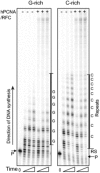DNA polymerase δ stalls on telomeric lagging strand templates independently from G-quadruplex formation
- PMID: 24038470
- PMCID: PMC3905856
- DOI: 10.1093/nar/gkt813
DNA polymerase δ stalls on telomeric lagging strand templates independently from G-quadruplex formation
Abstract
Previous evidence indicates that telomeres resemble common fragile sites and present a challenge for DNA replication. The precise impediments to replication fork progression at telomeric TTAGGG repeats are unknown, but are proposed to include G-quadruplexes (G4) on the G-rich strand. Here we examined DNA synthesis and progression by the replicative DNA polymerase δ/proliferating cell nuclear antigen/replication factor C complex on telomeric templates that mimic the leading C-rich and lagging G-rich strands. Increased polymerase stalling occurred on the G-rich template, compared with the C-rich and nontelomeric templates. Suppression of G4 formation by substituting Li(+) for K(+) as the cation, or by using templates with 7-deaza-G residues, did not alleviate Pol δ pause sites within the G residues. Furthermore, we provide evidence that G4 folding is less stable on single-stranded circular TTAGGG templates where ends are constrained, compared with linear oligonucleotides. Artificially stabilizing G4 structures on the circular templates with the G4 ligand BRACO-19 inhibited Pol δ progression into the G-rich repeats. Similar results were obtained for yeast and human Pol δ complexes. Our data indicate that G4 formation is not required for polymerase stalling on telomeric lagging strands and suggest that an alternative mechanism, in addition to stable G4s, contributes to replication stalling at telomeres.
Figures







Similar articles
-
Telomeric repeat mutagenicity in human somatic cells is modulated by repeat orientation and G-quadruplex stability.DNA Repair (Amst). 2010 Nov 10;9(11):1119-29. doi: 10.1016/j.dnarep.2010.07.014. Epub 2010 Aug 25. DNA Repair (Amst). 2010. PMID: 20800555 Free PMC article.
-
Intramolecular telomeric G-quadruplexes dramatically inhibit DNA synthesis by replicative and translesion polymerases, revealing their potential to lead to genetic change.PLoS One. 2014 Jan 14;9(1):e80664. doi: 10.1371/journal.pone.0080664. eCollection 2014. PLoS One. 2014. PMID: 24454683 Free PMC article.
-
The binding efficiency of RPA to telomeric G-strands folded into contiguous G-quadruplexes is independent of the number of G4 units.Biochimie. 2018 Mar;146:68-72. doi: 10.1016/j.biochi.2017.11.017. Epub 2017 Nov 29. Biochimie. 2018. PMID: 29191792
-
Interaction of G-quadruplexes with nonintercalating duplex-DNA minor groove binding ligands.Bioconjug Chem. 2011 Dec 21;22(12):2355-68. doi: 10.1021/bc200268a. Epub 2011 Nov 10. Bioconjug Chem. 2011. PMID: 22074555 Review.
-
G-Quadruplexes at Telomeres: Friend or Foe?Molecules. 2020 Aug 13;25(16):3686. doi: 10.3390/molecules25163686. Molecules. 2020. PMID: 32823549 Free PMC article. Review.
Cited by
-
Investigating G-quadruplex structures in RPGR gene: Implications for understanding X-linked retinal degeneration.Heliyon. 2024 Apr 18;10(8):e29828. doi: 10.1016/j.heliyon.2024.e29828. eCollection 2024 Apr 30. Heliyon. 2024. PMID: 38699732 Free PMC article.
-
Evolutionary dynamics of predicted G-quadruplexes in human and other great apes.Genome Biol. 2025 Jun 11;26(1):161. doi: 10.1186/s13059-025-03635-1. Genome Biol. 2025. PMID: 40500762 Free PMC article.
-
Detours to Replication: Functions of Specialized DNA Polymerases during Oncogene-induced Replication Stress.Int J Mol Sci. 2018 Oct 20;19(10):3255. doi: 10.3390/ijms19103255. Int J Mol Sci. 2018. PMID: 30347795 Free PMC article. Review.
-
G4-Interacting DNA Helicases and Polymerases: Potential Therapeutic Targets.Curr Med Chem. 2019;26(16):2881-2897. doi: 10.2174/0929867324666171116123345. Curr Med Chem. 2019. PMID: 29149833 Free PMC article. Review.
-
Functional interplay between SA1 and TRF1 in telomeric DNA binding and DNA-DNA pairing.Nucleic Acids Res. 2016 Jul 27;44(13):6363-76. doi: 10.1093/nar/gkw518. Epub 2016 Jun 13. Nucleic Acids Res. 2016. PMID: 27298259 Free PMC article.
References
-
- Palm W, de Lange T. How shelterin protects mammalian telomeres. Annu. Rev. Genet. 2008;42:301–334. - PubMed
-
- d'Adda di Fagagna F, Reaper PM, Clay-Farrace L, Fiegler H, Carr P, Von Zglinicki T, Saretzki G, Carter NP, Jackson SP. A DNA damage checkpoint response in telomere-initiated senescence. Nature. 2003;426:194–198. - PubMed
-
- Harley CB, Futcher AB, Greider CW. Telomeres shorten during ageing of human fibroblasts. Nature. 1990;345:458–460. - PubMed
-
- Bodnar AG, Ouellette M, Frolkis M, Holt SE, Chiu CP, Morin GB, Harley CB, Shay JW, Lichtsteiner S, Wright WE. Extension of life-span by introduction of telomerase into normal human cells. Science. 1998;279:349–352. - PubMed
Publication types
MeSH terms
Substances
Grants and funding
LinkOut - more resources
Full Text Sources
Other Literature Sources
Molecular Biology Databases

